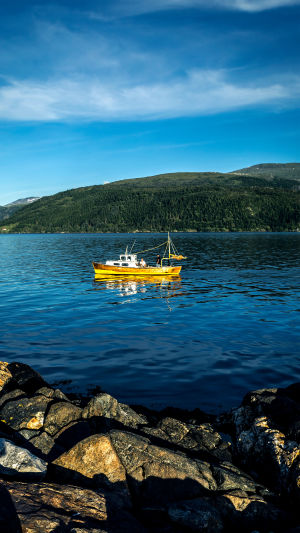The peak season for Norwegian mackerel fishing, also known as Atlantic Mackerel, occurs from September to November.
At the center of this bustling season is the “Birkeland,” a luxurious purse seiner, docked at Pelagia, the world’s largest Norwegian mackerel company.
This vessel, resembling a modern hotel, is designed to cater to Norwegian fishermen with a variety of rooms, relaxation areas, and state-of-the-art navigation, fish-finding, and fishing equipment. Most of these fishermen, vibrant and sun-kissed, are in their 30s and 40s, representing the peak of their fishing careers.
Even during the height of the fishing season, these dedicated fishermen are not bound to extended stays at sea. After capturing mackerel, they return to shore promptly to ensure the fish’s freshness, securing optimal market prices. This practice reflects the evolution of the Norwegian fishing industry—a transformation that has unfolded over nearly half a century, driven by innovation and adaptability.
With a coastline spanning over 101,000 kilometers, Norway’s aquaculture and fishing industry flourishes, positioning the country as the world’s second-largest exporter of marine products. Over the past forty years, Norway’s fisheries industry has overcome challenges like overfishing and disorganized management, emerging today as a global leader in sustainable ocean economy practices.
POPULAR ACTIVITY in Norway | FISHING MACKEREL IN NORWAY
Video by Piotur Fishing
Hans Worcester, the Seafood Department team manager at Leroy, a mid-sized Norwegian seafood company, expressed satisfaction with the government’s role in shaping the nation’s marine economy. Although he acknowledges occasional disagreements with regulations, Worcester appreciates their long-term benefits for the industry.
Knut Torgne, the sales director of Norges Sildesalgslag, a Norwegian fishermen’s sales organization, shares this view, highlighting the strengthened position of fishermen within the industry today. He emphasizes that the pursuit of sustainable development is a shared goal among those in fisheries, with government regulations playing an essential role.
Torgne further comments on the improved economic outlook for Norwegian pelagic fishermen, who now earn a respectable annual income of NOK 700,000 to 800,000—a notable contrast to the more modest livelihoods of fishermen in the 1960s.
Prior to the 1960s, although the Norwegian fishing industry experienced overall growth, challenges remained for those who depended on fishing as their primary livelihood.
The herring crisis of 1969 marked a turning point for Norway, prompting the Ministry of Fisheries to suspend new fishing vessel licenses. The introduction of a quota system in the 1970s, alongside incentives like exit subsidies and structural quotas, led to a significant reduction in the number of fishing vessels and fishermen.
In 1960, Norway had a record 42,000 registered fishing vessels and around 70,000 fishermen. By 2018, these numbers had dropped to fewer than 10,000 registered fishermen.
The discovery of offshore oil in 1969 also transformed the occupational landscape. The burgeoning oil industry attracted many fishermen with its higher income and favorable working conditions. At the same time, advancements in salmon farming technology in the 1970s encouraged some fishermen to shift from traditional fishing to aquaculture.
These transformative changes not only improved income security for fishermen but also eased the intensity of fishing efforts and regulatory pressures. Today, Norway’s fisheries industry exemplifies effective management, sustainable practices, and the resilience of fishermen who have adapted to the evolving dynamics of their trade.





